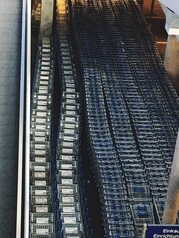The influence of the culinary offer on real estate value

The culinary offer of an area not only satisfies the palate but can also significantly elevate the value of properties in its surroundings. In a world where more and more people seek to live near unique culinary experiences, the connection between gastronomy and added value becomes undeniable. This article will explore how a varied and rich culinary offer can transform entire neighborhoods, attracting both investors and new residents willing to pay more to be close to their favorite restaurants.
The impact of gastronomy on neighborhood perception.
Gastronomy is not only a crucial aspect of the daily life of residents, but it also acts as a magnet to attract new tenants and homeowners. Neighborhoods with a rich culinary offering tend to generate a sense of community and belonging, where the diversity of restaurants, cafes, and local markets becomes an integral part of the lifestyle. This culinary vitality can transform people's perception of the neighborhood, creating a vibrant and dynamic image that resonates with potential buyers and tenants. Thus, an environment filled with unique culinary experiences can be seen as more desirable and appealing, enhancing its reputation and, therefore, its real estate value.
Additionally, the local gastronomy fosters social interactions that strengthen community ties. Restaurants and markets are not only places to enjoy good food; they also serve as meeting points where relationships are forged between neighbors and visitors. This type of social activity contributes to creating a welcoming atmosphere that invites more people to settle in the area. The constant presence of gastronomic events, local fairs, or culinary festivals not only enhances the quality of life but also promotes the economic development of the area. Consequently, this unique blend of culinary culture and community drives interest in the local real estate market, reflected in higher prices for properties near these offerings.
2. Restaurants as a driver of urban development
Restaurants, beyond being mere places to eat, act as catalysts for urban development. By establishing themselves in a neighborhood, they not only provide a dining service; they also create a vibrant atmosphere that attracts both visitors and residents. This constant flow of people fosters community life, encouraging the development of other local businesses, such as cafes, shops, and markets. As these new businesses flourish, the overall appeal of the area increases, which can lead to a rise in property prices. In this sense, restaurants not only enrich the cultural offerings of the neighborhood but also actively contribute to its economic dynamism.
The transformation of a neighborhood driven by its dining options is often accompanied by significant urban revitalization. Investments in public infrastructure and improvements in public space are common in areas where restaurants have started to thrive. Renovated parks, pedestrian streets, and better lighting are just a few examples of how the presence of dining establishments can motivate positive changes in urban quality of life. This improved environment not only benefits those who currently reside there but also attracts new buyers and tenants interested in living in an active area with its own character, further increasing the real estate value of the area.
3. The relationship between culinary offerings and real estate demand.
The relationship between culinary offerings and real estate demand manifests in various ways, starting with the attraction it generates among potential buyers. Areas with a rich culinary scene tend to become desirable destinations, not only for those looking for a place to live but also for investors who see the opportunity for attractive returns. Quality restaurants, distinctive cafés, and local markets can become magnets that increase the influx of people interested in settling in areas where the dining experience is an integral part of the lifestyle. This phenomenon, known as culinary gentrification, transforms communities and revitalizes neighborhoods, thereby elevating both demand and real estate values.
Additionally, gastronomy serves as a differentiating factor in an increasingly competitive real estate market. Developers and real estate agents recognize that a good culinary offering can be a key selling point when promoting properties. Statistics show that homes located near popular restaurants or areas with a high concentration of culinary options tend to have higher prices and a faster turnover in the market. Therefore, buyers are willing to pay a premium to live close to these unique places that enhance their quality of life and provide access to vibrant social experiences. In this sense, gastronomy not only feeds the body but also adds value to real estate investments.
4. Success stories: neighborhoods revitalized by gastronomy
The revitalization of neighborhoods through gastronomy is a phenomenon that has been observed in various cities around the world. Areas that were once considered forgotten or declining have resurfaced thanks to the arrival of innovative restaurants, food markets, and food trucks that attract both locals and tourists. A clear example is the case of Brooklyn in New York, where the diverse and creative culinary offerings have transformed old warehouses and factories into gastronomic hotspots; this has not only improved the quality of life for residents but has also significantly increased property values in the area.
Another emblematic case can be found in the neighborhood of La Latina in Madrid, where traditional taverns and modern gastro bars have turned this area into a popular destination for enjoying tapas and wines. This transformation has not only revitalized the local economy but has also attracted a younger and more dynamic population willing to invest in nearby housing. The combination of a vibrant atmosphere with a rich culinary offering translates directly into greater real estate demand, evidencing how gastronomy can be a key driver for urban development and the appreciation of real estate heritage.
5. Buyer profile: Who is looking to live near good restaurants?
The profile of the buyer looking to live near good restaurants is diverse, but a common pattern can be identified among them: an appreciation for quality of life. This group includes young professionals who value convenience and culinary culture, as well as families with children who wish to enjoy a variety of options for dining out or celebrating special occasions. Moreover, many buyers in this segment are willing to invest in properties that offer easy access to unique culinary experiences, considering this a vital element of their lifestyle. Gastronomy is not only seen as a recreational activity; for many, it represents an opportunity to socialize and create memories.
Another important aspect of the buyer profile is the focus on wellness and sustainability. The trend towards responsible consumption has led many people to seek restaurants that offer fresh and local ingredients, as well as healthy options. This means that neighborhoods with a varied and conscious culinary offering are especially attractive to those who prioritize a healthy lifestyle. Consequently, these buyers are often more inclined to pay a premium price for properties located in areas where they can enjoy not only good food, but also an environment that fosters their overall well-being and connection with the community.
6. Strategies for Owners: How to Enhance Real Estate Value Through Gastronomy
For owners looking to maximize the value of their property, a key strategy is to encourage and support the dining scene in their communities. This can be achieved by promoting local culinary events, such as food fairs, food festivals, or farmers' markets. By engaging in these initiatives, owners not only help create a vibrant and attractive environment but also establish a sense of community that can be very appealing to potential buyers and tenants. Additionally, collaborating with local restaurants to offer discounts or exclusive promotions can further enhance the area's perception as a desirable culinary destination.
Another effective strategy is to consider the development of properties that integrate culinary spaces, such as community kitchens or areas designed for food trucks and pop-ups. These facilities can not only attract culinary entrepreneurs but also serve as a focal point for residents and visitors. The presence of innovative and diverse dining options can make a property more appealing compared to other areas less focused on gastronomy. At the end of the day, those owners who understand the connection between their real estate investments and local dining experiences will be better positioned to capitalize on the long-term growth in the value of their properties.
7. Current trends in the food industry and their effect on the real estate market
Current trends in the culinary industry are redefining how people perceive and value urban spaces. The growing demand for authentic culinary experiences has led to a boom in the opening of restaurants, gourmet markets, and food trucks that not only offer food but also a social and cultural experience. This phenomenon has created a domino effect in the real estate market, where areas with a rich culinary offering tend to see a considerable increase in their appeal. Developers and investors are realizing that by incorporating quality restaurants and culinary entertainment options into their plans, they can elevate not only the interest in properties but also the sale prices.
Moreover, the popularity of concepts such as sustainable and local gastronomy is influencing the way neighborhoods are developed. Communities that promote farmers' markets or culinary events are especially valued by those buyers looking for not only a home but also a connection to their surroundings. This focus on the local not only contributes to improving the overall well-being of residents but also translates into an increase in real estate value. Therefore, it is evident that there is a symbiotic relationship between contemporary gastronomic trends and the development of the real estate market; where each new restaurant or culinary project can be seen as a catalyst for transforming entire neighborhoods and attracting new investments.
8. Future of the market: how will new culinary proposals influence added value?
The future of the real estate market presents itself as a dynamic scenario, where emerging culinary proposals will play a crucial role in property valuation. As consumers become more discerning and seek unique experiences, developers and restaurant owners are responding with innovative concepts that not only satisfy the palate but also create an attractive and vibrant environment. The emergence of food halls, culinary markets, and pop-ups allows for the diversification of the culinary offering in an area, thus generating a positive effect on the value of nearby properties. These initiatives feed not only the local appetite but also the demand for housing in areas where gastronomy is a main focus.
Furthermore, the integration of gastronomy with other forms of entertainment and culture can result in an even greater increase in added value. Spaces that combine art, music, and cuisine can attract a diverse and dynamic clientele, which in turn drives interest in living near these cultural epicenters. This phenomenon not only benefits real estate investors by increasing the value of their assets but also fosters a more cohesive and interesting community for future residents. In this context, it is essential for real estate agents and developers to recognize the transformative power of new gastronomic proposals as a strategic tool to enhance their market offerings.



